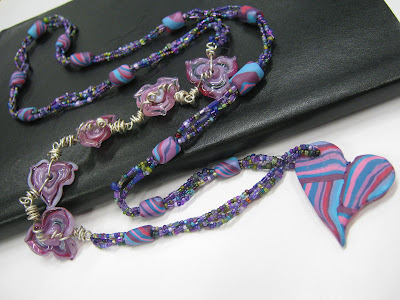I've been obsessing over polymer. But, it's hard to have a lot of time for it...between the migraines and real life.
General Observations about Polymer Clay vs. Lampwork
I've found that polymer clay has a low overhead in actual investment cost but a high investment in labor cost. The harder clays (Fimo and I've heard Kato is even harder) can take a while to condition. I will sit for an hour or two to condition 3-4 bars of clay. (Experienced clayers, if you feel like throwing in a few useful tips for conditioning a little faster, I'm open to suggestions!) The good thing is that once it's conditioned, it's not hard to recondition or get malleable again. And I'm loving mixing colors. However, it's still more labor intensive for a simple bead. On the other hand, once your colors are mixed and you have cane made, you can make make a complex piece faster. It still takes skill and precision. (I'm understanding this point as more than half of my last batch is in the scrap heap. I didn't even bother to save some of them.) And I've watched videos on some experienced clayers who have some beautifully complex pieces that took a long time to create.
Lampwork, on the other hand, lures you in with a somewhat low overhead. (You can get started for about $100 USD with a Hothead, glass, thermal blanket, mandrels, and bead release.) Until you get hooked. Then if you get serious, you need a kiln and good ventilation at a minimum. (Estimated $1,000 USD.) But, the likelihood is you're going to
have to experiment with frit. Tools. Expensive glass. Foil. Different sizes of mandrels. Bead release you like better. More colors of glass. More tools. Upgrade to an oxygen concentrator. Upgrade the torch. There is also a learning curve to working with molten 1600 degree (Fahrenheit) glass and a 900-1000 degree (Fahrenheit) kiln. It is an industrial art, so good care should be taken. But. Once you have all that, it's really quick to actually make spacer beads. (And another 30 minutes to soak, then 3 hours to ramp down and kiln anneal. It's so nail-biting to wait for the kiln to cool down and see how the glass behaved.) Oh and the more complex beads can take up to an hour or more (this last notation based on other blogs I've read of the lovely advanced lampworkers I read...not personal experience. I'm still on the simpler processes.) Instant gratification is not available to the lampworker (except for the making of spacers).
Summary
You'd think I was building up to some witty observation or wise feedback? No. I've got nothing for you. Just some blathering about glass and polymer clay.
I still miss glass. I have visions of what I want to create all the time and have to re-direct to polymer. But, I'm beginning to have more fun with polymer. I've had a few things people IRL (in real life) are reacting to, so I'm heading in the right direction.
I've packaged up a bunch of polymer offerings. I'm going through again to weed out and make sure my offerings are good. I even took photos. Next hurdle (as per my organization post) is getting things out into my shop. (I will conquer this task. I will. I will.)
First Polymer Giveaways
I've been creating Quilted Hearts. The first one was the Rainbow Quilted Heart. These are the latest.
Plaid Quilted Heart
The geometric design is based on doodlings I started doing in my sketchbook about 2 years ago. The plaid and dot design is perched on a graduated turquoise quilted heart and wrapped in a twisted cane.

Turquoise Quilted Heart
This heart is comprised of slices of graduated turquoise and place into a quilted pattern. Wrapped in a dark turquoise and silver wigwag cane.
 Lime & Turquoise Quilted Heart
Lime & Turquoise Quilted Heart
Using a similar pattern as the above heart, but alternating graudated lime greens and graduated turquoise.

for those of us who still speak in "inches" these polymer hearts are 1.75" tall by 1.5" wide
or if you speak metric 4.5 cm tall by 4 cm wide
You want one? Just comment on the blog about which one you want. First come, first served.









